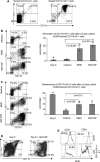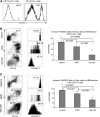GM-CSF is one of the main breast tumor-derived soluble factors involved in the differentiation of CD11b-Gr1- bone marrow progenitor cells into myeloid-derived suppressor cells
- PMID: 19898981
- PMCID: PMC3095485
- DOI: 10.1007/s10549-009-0622-8
GM-CSF is one of the main breast tumor-derived soluble factors involved in the differentiation of CD11b-Gr1- bone marrow progenitor cells into myeloid-derived suppressor cells
Abstract
Recent reports have shown the involvement of tumor burden as well as GM-CSF in supporting myeloid-derived suppressor cells (MDSC). However, it is not known what progenitor cells may differentiate into MDSC in the presence of GM-CSF, and whether FVBN202 transgenic mouse model of spontaneous breast carcinoma may exhibit distinct subset distribution of CD11b+Gr1+ cells. In addition, it is not known why CD11b+Gr1+ cells derived from tumor-free and tumor-bearing animals exhibit different functions. In this study, we determined that GM-CSF was one of the tumor-derived soluble factors that induced differentiation of CD11b-Gr1- progenitor cells from within monocytic/granulocytic bone marrow cells into CD11b+Gr1+ cells. We also showed that CD11b+Gr1+ cells in FVBN202 mice consisted of CD11b+Ly6G-Ly6C+ suppressive and CD11b+Ly6G+Ly6C+ non-suppressive subsets. Previously reported variations between tumor-free and tumor-bearing animals in the function of their CD11b+Gr1+ cells were found to be due to the variations in the proportion of these two subsets. Therefore, increasing ratios of CD11b+Gr1+ cells derived from tumor-free animals revealed their suppressive activity on T cells, in vitro. Importantly, GM-CSF supported the generation of CD11b+Ly6G-Ly6C+ suppressor subsets that inhibited proliferation as well as anti-tumor function of neu-specific T cells. These findings suggest revisiting the use of GM-CSF for the expansion of dendritic cells, ex vivo, for cell-based immunotherapy or as an adjuvant for vaccines for patients with cancer in whom MDSC play a major role in the suppression of anti-tumor immune responses.
Figures





Similar articles
-
Hierarchy of immunosuppressive strength among myeloid-derived suppressor cell subsets is determined by GM-CSF.Eur J Immunol. 2010 Jan;40(1):22-35. doi: 10.1002/eji.200939903. Eur J Immunol. 2010. PMID: 19941314
-
Lack of Muc1-regulated beta-catenin stability results in aberrant expansion of CD11b+Gr1+ myeloid-derived suppressor cells from the bone marrow.Cancer Res. 2009 Apr 15;69(8):3554-62. doi: 10.1158/0008-5472.CAN-08-3806. Epub 2009 Apr 7. Cancer Res. 2009. PMID: 19351842 Free PMC article.
-
IFN regulatory factor 8 represses GM-CSF expression in T cells to affect myeloid cell lineage differentiation.J Immunol. 2015 Mar 1;194(5):2369-79. doi: 10.4049/jimmunol.1402412. Epub 2015 Feb 2. J Immunol. 2015. PMID: 25646302 Free PMC article.
-
The role of CCR5 in directing the mobilization and biological function of CD11b+Gr1+Ly6Clow polymorphonuclear myeloid cells in cancer.Cancer Immunol Immunother. 2018 Dec;67(12):1949-1953. doi: 10.1007/s00262-018-2245-6. Epub 2018 Sep 19. Cancer Immunol Immunother. 2018. PMID: 30232521 Free PMC article. Review.
-
Myeloid-derived suppressor cells in breast cancer.Breast Cancer Res Treat. 2013 Jul;140(1):13-21. doi: 10.1007/s10549-013-2618-7. Epub 2013 Jul 5. Breast Cancer Res Treat. 2013. PMID: 23828498 Free PMC article. Review.
Cited by
-
Leveraging microenvironmental synthetic lethalities to treat cancer.J Clin Invest. 2021 Mar 15;131(6):e143765. doi: 10.1172/JCI143765. J Clin Invest. 2021. PMID: 33720045 Free PMC article. Review.
-
Role of Tumor-Associated Myeloid Cells in Breast Cancer.Cells. 2020 Jul 27;9(8):1785. doi: 10.3390/cells9081785. Cells. 2020. PMID: 32726950 Free PMC article. Review.
-
Immunosuppression mediated by myeloid-derived suppressor cells (MDSCs) during tumour progression.Br J Cancer. 2019 Jan;120(1):16-25. doi: 10.1038/s41416-018-0333-1. Epub 2018 Nov 9. Br J Cancer. 2019. PMID: 30413826 Free PMC article. Review.
-
Molecular pathways: myeloid complicity in cancer.Clin Cancer Res. 2014 Oct 15;20(20):5157-70. doi: 10.1158/1078-0432.CCR-13-0866. Epub 2014 Jul 21. Clin Cancer Res. 2014. PMID: 25047706 Free PMC article. Review.
-
Tolerance and immune suppression in the tumor microenvironment.Cell Immunol. 2016 Jan;299:23-9. doi: 10.1016/j.cellimm.2015.09.011. Epub 2015 Sep 30. Cell Immunol. 2016. PMID: 26435343 Free PMC article.
References
-
- Habibi M, Kmieciak M, Graham L, Morales JK, Bear HD, Manjili MH. Radiofrequency thermal ablation of breast tumors combined with intralesional administration of IL-7 and IL-15 augments anti-tumor immune responses and inhibits tumor development and metastasis. Breast Cancer Res Treat. 2009;114:423–431. - PMC - PubMed
-
- Ochoa AC, Zea AH, Hernandez C, Rodriguez PC. Arginase, prostaglandins, and myeloid-derived suppressor cells in renal cell carcinoma. Clin Cancer Res. 2007;13:721s–726s. - PubMed
Publication types
MeSH terms
Substances
Grants and funding
LinkOut - more resources
Full Text Sources
Other Literature Sources
Medical
Research Materials
Miscellaneous

